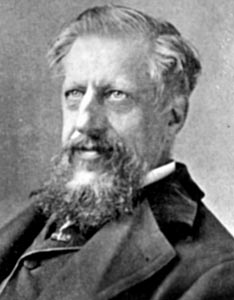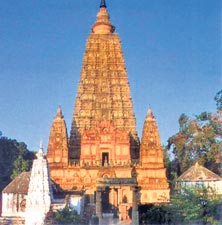Sir Edwin Arnold’s Light of Asia, published in 1879 was the first text, verse or otherwise, to bring to the Western world a more or less faithful account of the Buddha and Buddhism. Arnold’s interactions with Weligama Sri Sumangala Thera were to be the beginning of a momentous change for the Buddhist world. The idea to restore the sacred shrines of Buddha Gaya and Sarnath to the Buddhist guardians was first mooted at Rankoth Vihara in Panadura in 1886 in discussions between the two, a task taken up by others, mainly Anagarika Dharmapala under the guidance of Sumangala Thera.
 |
| Edwin Arnold |
It is useful to recall the background in which Sir Edwin wrote his Light of Asia and the deep connection with late 19th century Sri Lankan Buddhist revival. By 1861, Ven. Wakaduwe Subhuti’s temple Abhinavaramaya had established, what was in effect, the first International Buddhist Centre in the world, with foreign scholars consulting and studying under him. Later, Piyaratana Tissa Thera’s Sailabimbaramaya in Dodanduwa and Polwatte Buddhadatta Thera’s Aggaramaya in Ambalangoda Polwatte Buddhadatta Thera also became such centres.
To formalise the new interest in Buddhist learning, Hikkaduwe Sri Sumangala Nayaka Thera established the Vidyodaya Pirivena in 1873, and Ven. Ratmalane Sri Dhammaloka Maha Thera established Vidyalankara Pirivena in 1875. Thailand’s Maha Chulalankorn University/Monks’ College was soon modelled after these two Pirivenas.
Hikkaduwe Sumangala Thera and Weligama Sumangala Thera provided the Buddhist philosophical material for the crucial Panadura Buddhist Christian controversy held in 1873. The proceedings of this appeared in the print media in the US and enlightened Western readership on the Buddhist renaissance in Sri Lanka.
These scholar monks became the fist teachers of Western scholars like Childers, Geiger, Rhys Davids who studied Pali, Sinhala and Buddhism. Others such as Fausboll, Oldenberg, Rost, Muller, Minayeff, Lanman, Sir Edwin Arnold and Paul Carus – all corresponded with these scholar monks who provided the source material for their research and publication of books on Buddhism. Buddhist Studies Departments in many universities around the world today owe a deep debt of gratitude to these scholar monks of the 19th and early 20th centuries.
Arnold’s visit to Sri Lanka
Sir Edwin Arnold had been corresponding with Weligama Sumangala Thera for a long time, their common interest being Sanskrit literature. Arnold referred to the Thera as “my dear and wise friend, Sri Weligama”. The main purpose of his visit to Sri Lanka was to meet with Weligama Sumangala Thera. As Arnold landed in Sri Lanka in February 1886, he checked in at the Galle Face Hotel and went by train straight to Panadura Rankoth Vihara to meet the Thera. At Rankoth Vihara, around a thousand monks, men, women and children had gathered to welcome Arnold.
Arnold at the Panadura meeting mooted the idea of restoring to the Buddhists, Buddha Gaya and placing it in the hands of a representative committee of Buddhist nations. The monks and the laity now requested Arnold to take up the issue with the appropriate governmental authorities. He immediately took up the matter with the Governor of Ceylon, and later with the Governor of Madras, the Secretary of State for India, and the Viceroy himself.
Arnold later wrote, “I think there never was an idea which took root and spread so far and fast as that thrown out thus in the sunny temple-court at Panadura, amid the waving taliputs… Like those tropical plants which can almost be seen to grow, the suggestion quickly became an universal aspiration, first in Ceylon and next in other Buddhist countries”.
The second reception Arnold was accorded was at Vidyodaya Pirivena under the chairmanship of Hikkaduwe Sri Sumangala Thera. Around 3,000 monks and laity took part in it. Among those present was Col. H. S. Olcott, who by then was fully involved in the Buddhist renaissance movement. The monks honoured Arnold with speeches made in Pali and Sinhala. He replied in Sanskrit.
Arnold’s last stop was Kandy. The Mahanayaka Theras, the Diyawadana Nilame of the Dalada Maligawa and leading Buddhists in the area, received him with great honour. Arnold presented them with a Bodhi-leaf he had brought from Buddha Gaya. In return, the monks gifted Arnold with a begging bowl and a yellow robe.
Arnold later wrote about the event, “There I found them [Bodhi leaves] prized by the Sinhalese Buddhists with eager and passionate emotion. The leaf presented by me to the temple at Kandy, for example, was placed in a casket of precious metal and made the center of a weekly service”.
Arnold ready to sacrifice
life for Buddha Gaya
Anagarika Dharmapala inspired by Arnold went over to India in 1891 and pursued the cause of the restoration of Buddha Gaya. Dharmapala founded the Maha Bodhi Society expressly to wrest Bodh Gaya from Hindu control and to restore it to the Buddhists. Dharmapala also founded the Mahabodhi Journal to unite Buddhists around the world in order to solicit support for the cause. Dharmapala later wrote, “It was he [Arnold] who gave me the impulse to visit the shrine, and since 1891, I have done all I could do to make the Buddhists of all countries interested in the scheme of restoration…”
 |
| Buddha Gaya |
Arnold became the major campaigner for the restoration. He made representations to Sir Arthur Gordon, the Governor of Sri Lanka, Lord Dufferin in Calcutta and Lord Connemura in Madras.
He appealed through his numerous writings including in the British Daily Telegraph whose editor was Arnold. He wrote to politicians in Britain. He addressed gatherings of monks in Tokyo. He pleaded with the Indian Secretary of State. And Arnold accompanied Dharmapala to meet in London the Secretary of State for India on Dharmapala’s way to the Chicago Parliament of World Religions in 1893.
In a letter dated in September 1892, Dharmapala wrote to Weligama Thera from India about the Buddha Gaya issue, “I do not know why the Buddhists of Sri Lanka do not put in a greater effort even though Sir Arnold is exerting himself immensely ... Sir Edwin Arnold has stated in Japan that he was prepared to sacrifice his life for this purpose”.
In the decades that followed, Arnold’s and Weligama Sumangala’s common vision, carried through Dharmapala’s untiring efforts bore fruit. Bodh Gaya again became a meeting place for Buddhists and was restored to Buddhist control in 1947 – a site, one should remember, with strong direct ties to the Sinhalese since the 4th century CE. |



